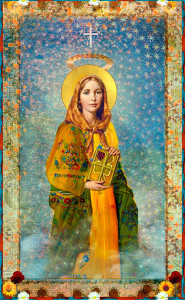
 Summary: St Davnet of Sliabh Beagh in Co Monaghan is popularly identified with Saint Dympna, whose relics are found in the Belgian town of Gheel. Such identifications, which historians say cannot be sustained, are quite common in the veneration of the saints.
Summary: St Davnet of Sliabh Beagh in Co Monaghan is popularly identified with Saint Dympna, whose relics are found in the Belgian town of Gheel. Such identifications, which historians say cannot be sustained, are quite common in the veneration of the saints.
As Patrick Duffy points out in this piece, every narrative has its own dynamic.
The Parish of Tydavnet, Co Monaghan
Saint Davnet (in Gaelic Damhnat) lived and died at Sliabh Beagh in the parish of Tydavnet (Tigh Damhnait = “house of Davnet”), Co. Monaghan. Tradition speaks of her as a virgin who in the sixth century founded a church or monastery in the area (generally considered to have been located in the graveyard of the current village Catholic church).
A 10th century ornamental pilgrim’s staff, the bachall Damhnait (“staff of Davnet”), said to have been hers is on display in the National Museum. In the past it was kept for generations in the parish and was often used as a test of truth. Her feast day is today, the 14th June.
Link with St Dympna, Patron of the Mentally iIl?
At Caldavnet at the northern end of the parish is well dedicated to St. Dympna, still a major place of pilgrimage. The local school is called St Dympna’s as is the major psychiatric hospital (built 1869-71) in nearby Monaghan town. Also there is a link between the village of Tydavnet and the town of Gheel 25 miles east of Antwerp in Belgium. The body of St Dympna, the patron saint of the mentally ill, is displayed in a silver reliquary in a church in Gheel named in her honour. She has her own feast on May 15th.
T he Life of St Dympna
he Life of St Dympna
The story of Dympna, the patron of the mentally ill comes from a 13th century Life of the saint, written by Pierre, a canon of St Aubert at Cambrai in the time of Bishop Guy I of Cambrai (1238-47). He tells that for many years she had been venerated at a church in Gheel dedicated to her. He says he has drawn his biography from oral tradition.
The Legend
According to the story, Dympna, the daughter of a pagan king of Ireland, became a Christian and was secretly baptised. After the death of her mother, a woman of extraordinary beauty, her own father wanted to marry her, his own daughter, who was just as beautiful. Dympna fled with the priest Gerebernus and landed at Antwerp, from where they went on to Gheel. Here they lived beside a chapel of St. Martin. The father discovered their whereabouts and came to renew his offer. But seeing that all was in vain, he told his servants to kill the priest, while he himself cut off the head of his daughter. The corpses were put in sarcophagi in a cave where they were later found. The body of St. Dympna was buried in the church of Gheel, and the bones of St. Gerebernus were transferred to Kanten.
Fragments and Relics
There are at Gheel fragments of two simple ancient sarcophagi in which tradition says the bodies of Dympna and Gerebernus were found. There is also a quadrangular brick, said to have been found in one of the sarcophagi, bearing two lines of letters read as DYMPNA. And the discovery of this sarcophagus with the corpse and the brick was perhaps the origin of the veneration.
After the finding of the tombs, it is said that a number of epileptics, insane people, and some said to be under diabolical influence were cured by the relics of Dympna. Ever since, she has been invoked on behalf of such people. Gheel itself built an infirmary for the mentally ill, and today it boasts a flourishing state sanitarium that has advanced types of care for its patients. Most of them are able to board with neighbourhood farmers, who become like “foster families” for them, while they help with the household chores as much as they are able.
On St Dympna’s feast day 15th May many people, both healthy and mentally ill, still come to the tomb of St Dympna.
Is it True?
This story is probably a variation of the motif frequent in popular legends of a king who wants to marry his own daughter and the terrible consequences. It might be rash to claim that the legend is absolutely true or that Dympna and Davnet are the same person. But it might also be equally rash totally to discount the value of these stories and the links between Tydavnet and Gheel. As the Italians say: Se non è vero, è ben trovato. (“If it’s not true, it’s still a good story”). Every narrative has its own dynamic.
____________________________
******************************
Memorable Prayer for the mentally ill Today
We beg you, Lord, to hear the prayers of St. Dymphna on our behalf.
Grant all those for whom we pray patience in their sufferings
and resignation to your divine will.
Please fill them with hope, and grant them the relief
and cure they so much desire.
~ A humble patient ~
******************************